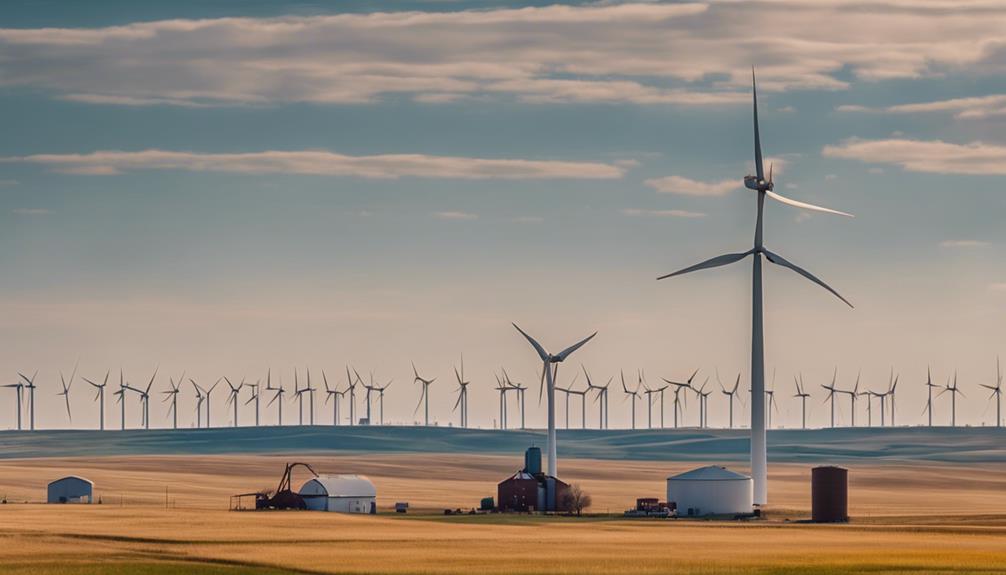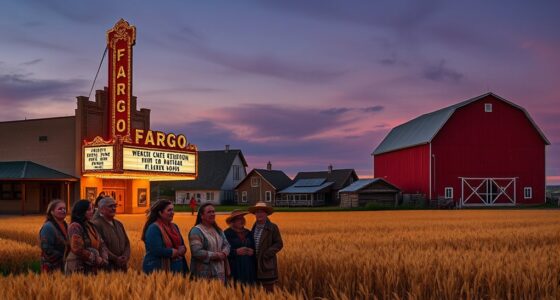Begin a journey through North Dakota's Great Plains, where Lewis and Clark's expedition marked significant milestones. The enduring presence and resilience of Native American tribes like Mandan, Hidatsa, Sioux, and Chippewa have deeply influenced the region's identity. The pioneering spirit, settlement, and challenges faced in the frontier life have shaped North Dakota's history. Cultural heritage, environmental conservation efforts, and sustainable development strategies showcase the adaptability and resilience of its people. Modern economic prospects in agriculture, energy, and manufacturing industries contribute to the region's diverse economic portfolio. Discover more about the rich heritage and promising future of North Dakota's Great Plains.
Key Takeaways
- Influence of Lewis and Clark expedition on North Dakota's exploration.
- Resilience and cultural impact of Native American tribes.
- Settlers' pioneering spirit in North Dakota's history.
- Economic opportunities in agriculture, energy, and manufacturing.
- Conservation efforts to protect the environment and heritage.
History of Exploration in North Dakota
Explore the rich history of North Dakota through the lens of early expeditions led by famous explorers like Lewis and Clark. Their journey along the Missouri River in North Dakota marked significant milestones in the exploration of the region.
Passing the mouth of the Little Missouri River on April 12, 1805, Lewis and Clark's expedition continued to Fort Mandan, where they established their winter quarters on October 26, 1804. As they ventured further, they reached the Yellowstone River on April 26, 1805, before meeting Captain Clark's group in present-day North Dakota on August 12, 1806.
The combined Corps then descended the Missouri River, passing various river mouths like the Little Missouri and Grand River along the way. These expeditions not only paved the way for further exploration but also provided invaluable insights into the geography and resources of North Dakota's plains. Lewis and Clark's endeavors remain pivotal in understanding the early exploration of the region.
Native American Presence on the Plains

Native American tribes such as the Mandan, Hidatsa, Arikara, Sioux, and Chippewa established vibrant communities on North Dakota's Great Plains, contributing to the cultural tapestry of the region.
Despite facing adversity like forced relocation and the near extinction of the bison, Native Americans displayed remarkable resilience, preserving their traditions and enriching the history of North Dakota.
Today, their enduring presence serves as a proof to the strength and endurance of Indigenous cultures in the face of challenging circumstances.
Tribal Cultures on Plains
The presence of major tribes like Mandan, Hidatsa, Arikara, Sioux, and Chippewa on North Dakota's Great Plains added a rich cultural tapestry to the region. Native Americans inhabited these lands long before European settlers arrived, bringing with them unique tribal cultures that thrived in harmony with the vast plains.
These tribes had distinct traditions, languages, and social structures that shaped their way of life on the plains.
The tribal cultures faced challenges and changes during the Frontier Era, as the arrival of settlers and the push for westward expansion disrupted their traditional way of life. Despite these challenges, Native American tribes on the plains played a significant role in shaping the history and landscape of the region.
Their resilience and traditions continue to influence North Dakota's identity today, serving as a reminder of the enduring legacy of the indigenous peoples who called the Great Plains home.
Indigenous Resilience Today
Indigenous tribes like the Mandan, Hidatsa, Arikara, Sioux, and Chippewa persist in enriching North Dakota's cultural heritage today through their continued presence on the Great Plains. Despite historical challenges, these Native American communities showcase remarkable indigenous resilience, maintaining a strong and enduring presence in the region.
Here are some key aspects highlighting the resilience of Indigenous tribes on the Great Plains:
- Cultural Preservation: Native American tribes actively preserve their languages, customs, and spiritual traditions, ensuring that their rich heritage is passed down through generations.
- Community Strength: Despite adversities, indigenous communities on the Great Plains demonstrate remarkable unity and solidarity, supporting one another in times of need.
- Historical Continuity: Traditional practices deeply rooted in the history of these tribes continue to thrive, contributing significantly to the vibrancy of North Dakota.
- Identity Formation: Indigenous communities play a pivotal role in shaping the identity and history of North Dakota's Great Plains, emphasizing the importance of acknowledging and respecting their presence.
Impact of Lewis and Clark Expedition

The Lewis and Clark Expedition left a lasting legacy in the Great Plains, shaping the course of exploration and discovery in the region. Their impact resonates to this day, influencing how we perceive the vast frontier that once stretched before them.
The expedition's journey stands as a tribute to the enduring spirit of exploration and the quest for knowledge that defined the early days of America's westward expansion.
Lewis and Clark Legacy
Exploring the Great Plains, Lewis and Clark's expedition greatly influenced the understanding of the region's natural history through encounters with diverse wildlife species. This legacy continues to shape perceptions of the Great Plains and the frontier spirit that characterized their journey.
Here are some key points regarding the Lewis and Clark Legacy:
- The expedition's documentation of various mammal species, such as the bighorn sheep observed at the mouth of the Yellowstone River, provided valuable insights into the natural history of the Great Plains.
- By mapping and exploring the vast wilderness of the region, Lewis and Clark contributed to the scientific understanding of the flora and fauna in the Great Plains.
- Captain Clark's observations of the bighorn sheep, known as rock mountain sheep by the French, highlighted the unique characteristics of the Great Plains wildlife population.
- The enduring scientific and historical significance of Lewis and Clark's expedition underscores its critical role in shaping our knowledge of the natural world in the Great Plains.
Exploration Impact Today
Even today, the impact of the Lewis and Clark Expedition resonates in the scientific understanding of North Dakota's natural history. The exploration impact made by Lewis and Clark continues to influence our knowledge of the region's natural environment.
As they journeyed through present-day North Dakota, documenting various mammals and establishing Fort Mandan for winter quarters, they provided valuable insights into the flora and fauna of the area. Their encounters with the Yankton Sioux natives in South Dakota further enriched their exploration impact, adding cultural significance to their scientific endeavors.
The discovery of Burning Bluffs with warm rocks along the Missouri River in August 1804 stands as evidence of the expedition's contributions to our understanding of the region.
Today, the scientific legacy of Lewis and Clark's expedition persists, shaping our ongoing research and conservation efforts in North Dakota's natural environment. Their meticulous documentation and observations continue to inform and guide studies on the Great Plains' biodiversity and ecological history.
Frontier Exploration Influence
Venture into the legacy of Lewis and Clark's expedition as it shapes the frontier exploration influence in North Dakota. The impact of the Lewis and Clark Expedition on North Dakota's frontier exploration is profound and enduring. Here's how their journey continues to influence the region:
- Establishment of Fort Mandan: In 1804, Lewis and Clark established Fort Mandan in present-day North Dakota as their winter quarters, showcasing the importance of strategic planning and resourcefulness in frontier exploration.
- Interaction with Native American Tribes: The expedition's interactions with tribes like the Awatixa Hidatsa and Teton Lakotas highlighted the significance of diplomacy and cultural understanding in exploring new territories.
- Documentation of Natural History: By meticulously documenting the region's natural history, including diverse wildlife like bighorn sheep, Lewis and Clark provided valuable scientific insights that laid the foundation for future exploration and research.
- Legacy of Exploration: Their exploration along the Missouri River in North Dakota set a precedent for future frontier explorers, leaving a lasting impact on the spirit of adventure and discovery in the region.
Settlement and Pioneering Spirit

Driven by a pioneering spirit, settlers from various ethnic backgrounds sought new opportunities in the Great Plains of North Dakota. The allure of land policies promising ownership and agricultural potential enticed these early pioneers to brave the challenges of the rugged environment. The settlers' resilience and determination were tested by the harsh conditions of the Great Plains, but their innovative farming techniques and communal support networks helped establish flourishing communities. Despite the hardships, the pioneering spirit fostered a strong sense of community, cooperation, and perseverance among the settlers.
The Great Plains provided a blank canvas for these pioneers to paint their dreams of a better life. The promise of land ownership and the potential for agricultural success fueled their journey westward. Through hard work and ingenuity, the settlers in North Dakota's Great Plains laid the foundation for future generations to thrive in this frontier land.
The pioneering spirit that drove these early settlers continues to inspire the modern residents of North Dakota, reminding them of the resilience and determination that built their communities.
Challenges of Frontier Life

Endurance was key for frontier settlers in North Dakota, facing harsh winters and isolation in the Great Plains. Living on the American frontier presented numerous challenges, testing the limits of those who dared to carve out a life in the untamed wilderness.
Here are some of the difficulties that frontier inhabitants had to contend with:
- Limited Resources: Access to essential supplies and services was scarce, forcing settlers to make do with what little they had.
- Threat of Conflicts: Constant tensions with American Indian tribes loomed over daily life, adding an element of danger to an already challenging existence.
- Lack of Infrastructure: The absence of basic amenities like roads and medical facilities made maneuvering frontier life even more treacherous.
- Harsh Environment: The rugged terrain and unpredictable weather conditions demanded unwavering resilience and adaptability from those who called the Great Plains home.
Surviving on the frontier required a combination of grit, resourcefulness, and sheer determination.
Economic Opportunities in the Plains

Living on the American frontier in North Dakota's Great Plains may have been challenging, but it also offered significant economic opportunities for those willing to seize them.
The vast expanse of the region provides fertile ground for agriculture, with crops like wheat, barley, and soybeans thriving in the soil. The agricultural industry in the Great Plains supports local communities and contributes to the overall economy.
Additionally, energy development plays an essential role in the economic landscape of the Plains, with resources such as oil and natural gas driving growth and providing employment opportunities for residents.
Manufacturing sectors in the region focus on machinery, food processing, and technology industries, adding to the diverse economic portfolio of the area.
The dynamic business environment in the Great Plains fosters innovation and growth, making it an attractive destination for those seeking economic prospects in agriculture, energy, and manufacturing.
Cultural Heritage of the Great Plains

Enriched by the contributions of Native American tribes and the enduring legacy of German-Russian migration, North Dakota's Great Plains boast a cultural heritage that's deeply woven into the fabric of the region. This heritage is a blend of traditions, languages, and practices that have shaped the identity of the area for generations.
Here are some key aspects of the cultural heritage of the Great Plains:
- Native American Tribes: The Mandan, Hidatsa, Arikara, Sioux, and Chippewa tribes have played an essential role in shaping the cultural landscape of North Dakota, leaving behind a rich tapestry of customs, art, and spirituality.
- German-Russian Migration: The settlement patterns of German-Russian immigrants have left a lasting impact on the social and ethnic makeup of North Dakota, fostering communities that have retained their unique language and customs.
- Economic Influence: The discovery of oil in the late 20th century hasn't only influenced the economic prosperity of the region but has also impacted the cultural dynamics of North Dakota.
- Historical Themes: North Dakota's history is characterized by themes of dependence, radicalism, and economic challenges, reflecting the resilience and adaptability of its people over time.
Modern-Day Resilience in North Dakota

In light of North Dakota's historical resilience and enduring frontier spirit, the state's ability to adapt to modern economic challenges, especially the recent oil boom, showcases a continued sense of strength and determination among its residents.
Modern-day North Dakota stands as a demonstration of the unwavering spirit of its people, who've embraced change while staying true to their roots. The recent oil boom in the western part of the state exemplifies this adaptability, with North Dakotans leveraging their strong sense of community and heritage to navigate the evolving economic landscape.
Despite facing harsh weather conditions and geographical isolation, North Dakota has thrived, drawing on its frontier spirit to overcome obstacles and forge ahead. The state's dedication to preserving its cultural heritage further underscores its resilience in the face of modern challenges.
Conservation Efforts in the Region

Preserving the prairie ecosystem in North Dakota is a primary focus of the state's conservation efforts. Conservation initiatives in the region encompass various aspects of the ecosystem, including grasslands, wetlands, and wildlife habitats.
Key points to note about conservation efforts in North Dakota are:
- The establishment of wildlife refuges and conservation areas like the J. Clark Salyer National Wildlife Refuge and the Lostwood National Wildlife Refuge.
- Protection measures for endangered species such as the whooping crane and the piping plover.
- Promotion of sustainable agriculture practices to safeguard soil health and prevent erosion in the Great Plains.
- Engagement of local communities in conservation projects to enhance awareness and participation in preserving North Dakota's natural environment.
Through these collaborative efforts, North Dakota aims to maintain the delicate balance of its prairie ecosystem while involving and educating its residents in the importance of conservation.
Future Prospects for the Great Plains

Looking ahead, the future prospects for the Great Plains in North Dakota encompass sustainable development practices to safeguard the unique ecosystem and support local communities. The region's agricultural potential remains a focal point, with efforts directed towards enhancing productivity while maintaining environmental integrity. Sustainable development initiatives aim to strike a balance between economic growth and conservation, ensuring the longevity of the Great Plains' natural resources.
Renewable energy projects, particularly wind farms, are gaining traction in the Great Plains as a means to harness clean energy sources and reduce reliance on non-renewable energy. Innovation in agriculture plays a significant role in shaping the future of the region, with precision farming techniques and crop diversification leading to increased efficiency and sustainability.
Collaborative endeavors among stakeholders underscore a commitment to responsible land use practices and the preservation of the Great Plains' unique ecosystem. By embracing sustainable development strategies, North Dakota's Great Plains are poised to thrive economically while safeguarding the environment for future generations.
Frequently Asked Questions
Who Lived in North Dakota Before the Frontier Era?
Before the Frontier Era, Native American tribes like the Mandan, Hidatsa, Arikara, Sioux, and Chippewa inhabited North Dakota. These tribes had established communities, engaging in hunting, farming, and trade along the river valleys and plains.
Known for their intricate social structures and unique spiritual beliefs, they greatly influenced the land and laid the foundation for North Dakota's cultural heritage. Their presence predates the Frontier Era, shaping the region in profound ways.
What Are the Four Indian Reservations in North Dakota?
The four Indian reservations in North Dakota are Standing Rock, Spirit Lake, Turtle Mountain, and Fort Berthold.
Standing Rock Reservation is shared with South Dakota and gained prominence during the Dakota Access Pipeline protests.
Spirit Lake Reservation is situated in Benson County and is home to the Spirit Lake Sioux Tribe.
Turtle Mountain Reservation, located in Rolette County, houses the Turtle Mountain Band of Chippewa Indians.
Fort Berthold Reservation, in the western part of the state, is the residence of the Mandan, Hidatsa, and Arikara Nation.
What Is the History of the Native American People in North Dakota?
The history of Native American people in North Dakota is rich and diverse. Tribes such as the Mandan, Hidatsa, Arikara, Sioux, and Chippewa have inhabited the region for centuries, each with unique cultures and traditions.
European exploration, starting in 1738, brought significant changes to the area. The Dakota Territory, established in 1861, eventually led to North Dakota gaining statehood in 1889.
Immigrant groups like German Americans, Scandinavian Americans, and Yankees also influenced the state's development.
Is North Dakota in the Northern Plains?
Indeed, North Dakota is nestled in the Northern Plains, showcasing a picturesque landscape of vast grasslands and rolling hills.
The state's climate boasts cold winters and warm summers, defining its unique charm.
This region's frontier spirit is deeply rooted in the history of exploration and settlement, shaping North Dakota's identity.
Embrace the allure of the Northern Plains and immerse yourself in the rich tapestry of North Dakota's heritage.
Conclusion
To sum up, North Dakota's Great Plains and frontier spirit have shaped a rich history of exploration, settlement, and cultural heritage.
Today, the region continues to thrive with a resilient population dedicated to preserving its natural beauty and wildlife.
An interesting statistic to note is that North Dakota is home to over 63,000 farms, showcasing the enduring agricultural tradition that has been a cornerstone of the state's economy for generations.










